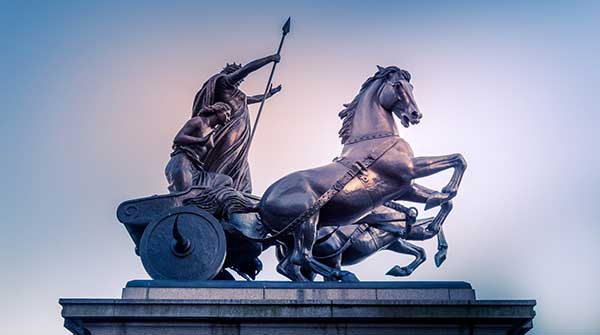Boudica’s moment of fame came as the leader of a revolt against the Romans in the years 60-61
 Most legendary national heroes tend to be men, or at least that was the case in the world I grew up in. But there are exceptions, one of which is the 1st-century Englishwoman Boudica.
Most legendary national heroes tend to be men, or at least that was the case in the world I grew up in. But there are exceptions, one of which is the 1st-century Englishwoman Boudica.
Boudica was queen of the Iceni, a pre-Saxon tribe that inhabited a territory in eastern England, roughly consisting of modern Norfolk and bits of Lincolnshire, Suffolk and Cambridgeshire. Her moment of fame came as the leader of a revolt against the Romans in the years 60-61.
Written records from antiquity being sparse, most of what we think we know about the Iceni and Boudica is filtered through Roman eyes, the historian Tacitus being one of the most cited sources. Tacitus, it’s worth noting, tended to take a sympathetic view of the “barbarian” tribes who resisted Roman rule. So while his rendering would’ve naturally reflected the perspective of his place and time, he wasn’t an unvarnished cheerleader for Roman imperial adventures.
 Boudica and her daughters |
| Related Stories |
| Battle of Agincourt one of the most famous battles in history
|
| Gaining perspective: Princess Diana’s death 25 years on
|
| The last children of Anglo-Saxon England
|
The serious Roman footprint in England dates from the invasion in the year 43, which posed a question for the native tribes. Should they resist or come to an arrangement?
The Iceni opted for the latter, accepting the Romans as overlords and thus effectively becoming a client kingdom. Perhaps they saw resistance as futile. Or maybe they figured that cutting a deal would bring Roman protection against the hostile intentions of other tribes.
The arrangement went off the rails when the king, Boudica’s husband, died without a male heir. In an effort to preserve family power, he had named his two daughters and the Roman emperor Nero as coheirs to his kingdom. The Romans, however, didn’t recognize the concept of female inheritance and seized the opportunity to take it all.
And the manner in which they went about it was particularly brutal, incorporating the flogging of Boudica and the rape of her two daughters. That would show everyone who was top dog!
Except it didn’t. At least not initially.
Thoroughly incensed, Boudica went to war, enlisting not just the Iceni but also other tribes nursing grievances. Saying that she was out for blood is putting it mildly.
Reputedly, Boudica cut an impressive physical figure. Tall and with red hair down to her waist, she was brave, fierce and apt to go into battle driving a chariot. To the modern mind, it sounds like a comic book image of an Amazon warrior.
Colourful, even fanciful images notwithstanding, she did raise a huge force and set about sacking Roman towns. The antecedents of modern Colchester, St. Albans and London were burned to the ground amid the wholesale slaughter of the inhabitants, whether Roman or not.
But if the Romans appeared to be on the ropes, that was a misleading impression. They quickly regrouped and – thanks to a professional military and a choice of battle terrain that mitigated Boudica’s substantial numerical advantage – won the decisive encounter. If anything, the resulting carnage exceeded that accompanying Boudica’s triumphs. In the words of Tacitus, the Romans “made a desert and called it peace.”
The Roman presence continued for several centuries and developed a generally positive reputation among later historians. Although they never conquered the entire island of Britain, the Roman remit was extensive and introduced modernizing features such as a road network and water supply and sanitation systems. When they withdrew militarily in 410, not all Britons were happy.
As for Boudica, she didn’t long survive the defeat of her army, perishing by either sickness or suicide. But the seeds of her legend were well and truly sown. Sometimes she was seen as a “baddie,” other times as a hero.
The 19th century was good for her profile. Victorian Britain was in a mood to celebrate legendary national heroes, even if relatively little was truly known about them or their real connection with Britain was tenuous.
For instance, the imposing bronze statue of Richard the Lionheart that stands outside the Palace of Westminster dates from the mid-19th century. While he was a famous 12th-century king of England, Richard was substantively French and viewed England as little more than a source of revenue.
Boudica’s statue, depicting her and her daughters in a scythed chariot drawn by two rearing horses, was also created in the 19th century and erected on the north side of Westminster Bridge in 1902. It became a rallying symbol for the early suffragette movement.
To borrow a phrase from the late journalist/historian Paul Johnson, Boudica’s statue “is a fitting memorial to a woman part fact, part fiction.” Heroes are often like that.
Pat Murphy casts a history buff’s eye at the goings-on in our world. Never cynical – well, perhaps a little bit.
For interview requests, click here.
The opinions expressed by our columnists and contributors are theirs alone and do not inherently or expressly reflect the views of our publication.
© Troy Media
Troy Media is an editorial content provider to media outlets and its own hosted community news outlets across Canada.

